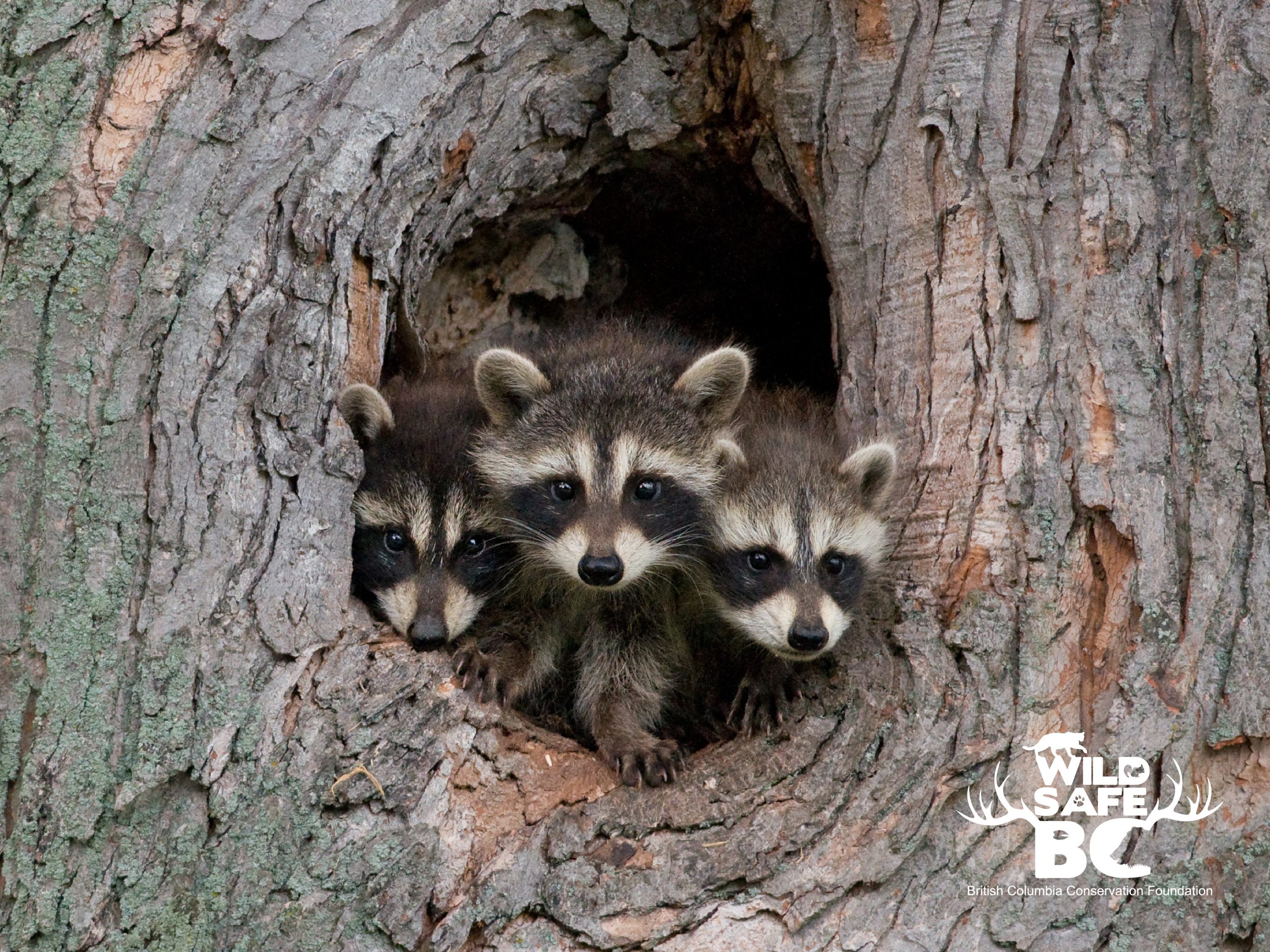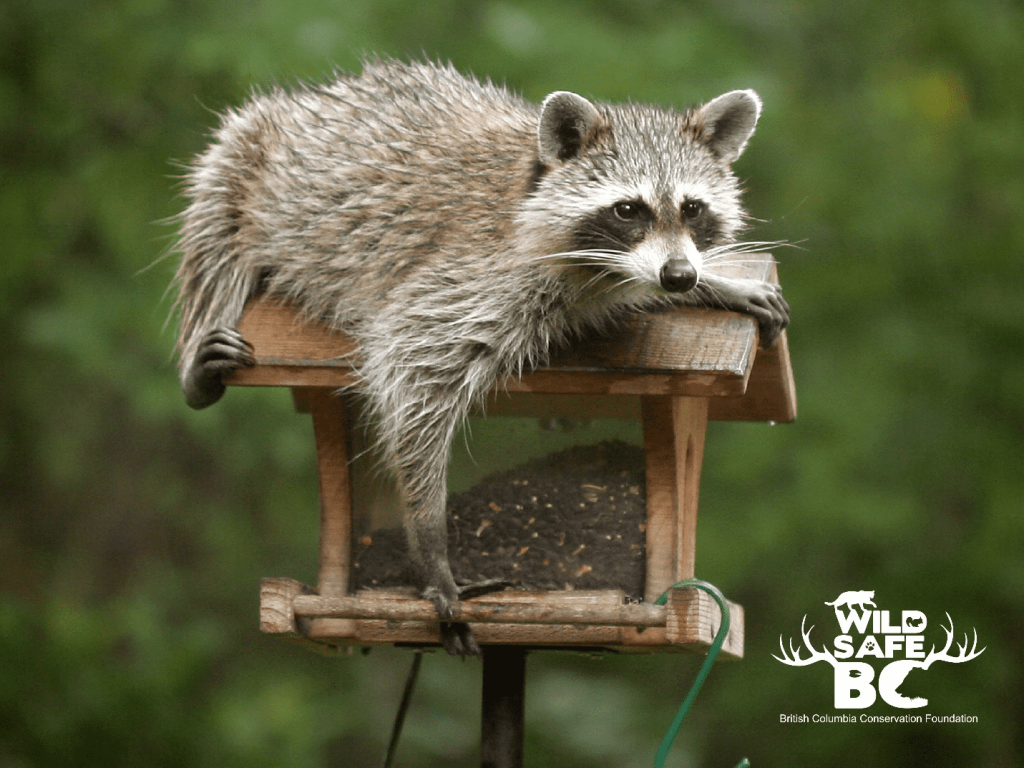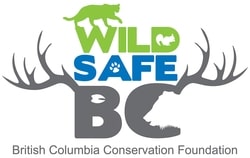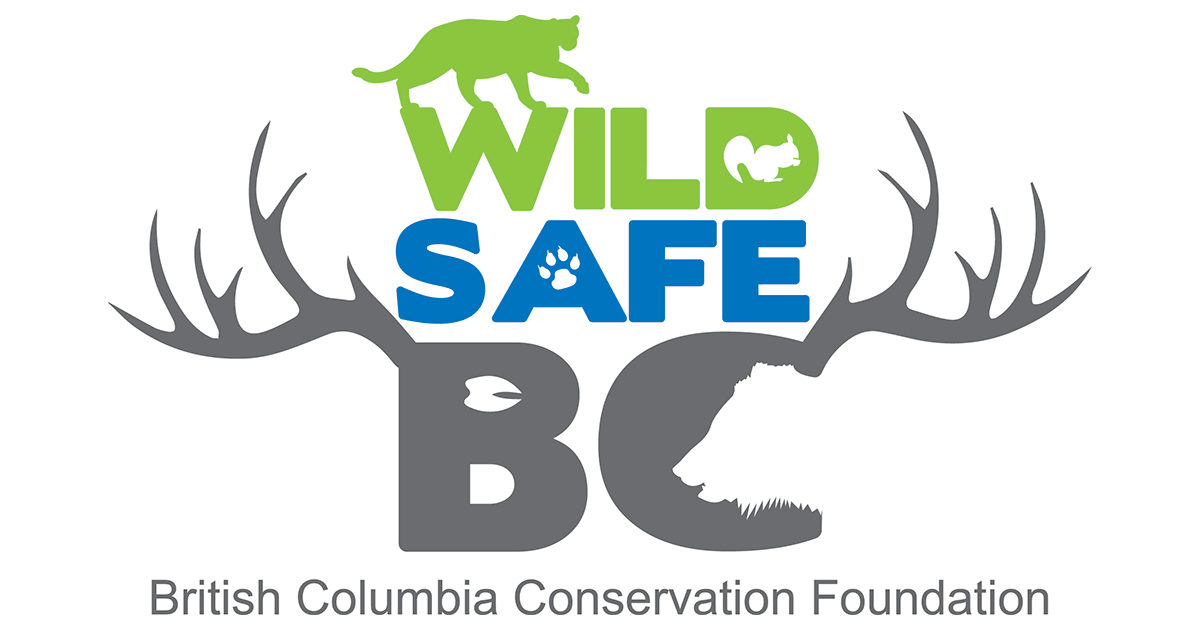Raccoon
Raccoon Snapshot
Raccoons (Procyon lotor) can be found throughout Southern BC including Haida Gwaii, Vancouver Island and the Southern Interior. Raccoons are opportunistic omnivores, feeding on an extremely varied diet and continually exploring their habitat to exploit new food sources. Highly adaptable, raccoons can thrive in the densest of urban centers.
Raccoons can cause significant damage to gardens, buildings, crops, and livestock in their search for food and denning sites. Some people feed raccoons under the mistaken idea that this helps them. Food-conditioned and human-habituated raccoons become bolder around humans and can even cause injury. A high percentage of raccoons can carry a roundworm parasite that is potentially dangerous to humans and care should be taken in dealing with feces left by raccoons. While raccoons have the potential to carry rabies, there have been no cases of rabies found in raccoons in BC. Children should be taught not to approach any wildlife, as serious bites and scratches may result from an encounter with a raccoon.
Raccoons are protected under the BC Wildlife Act. While trapping and relocating raccoons without a permit is allowed if they are causing damage on a person’s property, it can be challenging to do so humanely and safely. WildSafeBC recommends exploring other options under “Conflict Reduction” that may have longer lasting results. If removal is necessary, consider contacting a qualified pest management contractor.
Wild Raccoon Facts
- Raccoons are opportunistic omnivores and are known to eat just about anything edible.
- Raccoons have incredibly sensitive and dexterous forepaws which allow them to exploit a variety of food sources.
- Their habit of catching aquatic creatures like crayfish, minnows, and frogs has led to the myth that raccoons wash their food before eating it.
- They are excellent swimmers and very capable tree climbers.
- Like bears, raccoons in much of their Canadian range have a winter denning period where they sleep away the harsh winter months.
- Raccoons that dig up lawns to eat grubs may actually be helping to remove the invasive European Chafer beetle.
Identification
Raccoons are easily identified by their characteristic black eye mask and striped tail. Raccoons measure between 60-95 centimeters from nose to tail and tend to weigh between 6-8 kilograms. Females tend to be approximately 25% smaller than males.

Biology
Raccoons can breed from January through to June, but peak breeding occurs from March to April. Raccoons usually give birth to two to three young called kits approximately two months after breeding. They are ready to leave the den by seven weeks of age and will follow their mother into the fall. When raccoons are 12 weeks they are weaned and able to forage on their own. Some will disperse while others will den with their mother until spring.
Raccoons are opportunistic omnivores and are known to eat just about anything edible. Some preferred foods include nuts, insects, berries, clams and bird eggs. Raccoons have incredibly sensitive and dexterous forepaws which allow them to exploit a variety of food sources. Their habit of catching aquatic creatures like crayfish, minnows, and frogs has led to the myth that raccoons wash their food before eating it.
Raccoons in the wild have a relatively short average life span due to high mortality amongst the young. While wild raccoons have a life expectancy of three to five years, raccoons in captivity can live upwards of 15 years.
Raccoons have several predators including coyotes, cougars, wolves, and great-horned owls. Other threats include disease, vehicle collisions and starvation in harsh winters.
Behaviour
Raccoons tend to be solitary animals (except for females with young) but they will congregate if there is a good food source. They will also den together as family groups. Raccoons are primarily nocturnal, but may be seen foraging during the day. Raccoons are excellent swimmers and very capable tree climbers.
Raccoons enter a fattening up period in the fall to prepare for their denning season in the winter. They may accumulate a layer of fat up to 2.5 centimeters thick. In much of their Canadian range, raccoons sleep away the harsh winter months. This is not a true hibernation but rather a period of inactivity to survive a time of food scarcity. In warmer regions or urban cores where food is available throughout winter, raccoons may stay active year-round.
Range and Habitat
Raccoons prefer forested areas near water but they are well-adapted to living in a variety of habitats including urban environments. They are found on the South Coast, Vancouver Island, Haida Gwaii, and have expanded their range into the Southern Interior including the Thompson/Okanagan.
Raccoon den sites vary widely and can be found in hollow trees, stumps, and abandoned burrows as well as in buildings such as barns and attics.
Raccoon Safety
Raccoons can become aggressive towards humans if cornered or handled. Given their small size, they do not pose a serious threat but they are capable of inflicting minor injuries. If approached by a raccoon, scare it away by yelling, clapping, or making noise.
Keep small pets inside, especially at night. Cats and small dogs can be seriously injured or even killed in conflicts with raccoons.
Never attempt to approach a raccoon. Like all wildlife, raccoons act aggressively if threatened.
While raccoons have the potential to carry rabies, there have been no cases of rabies found in raccoons in BC.
A high percentage of raccoons may carry dangerous parasitic roundworm (Baylisascaris). The eggs are shed in their feces and can lead to humans becoming infected if ingested or inhaled. Raccoons may use communal latrines or defecate in the same area repeatedly. It is important to recognize a raccoon latrine and prevent children and pets from approaching. Raccoon latrines are often found at the base of trees, on logs, rocks, woodpiles, patios and even attics or garages. Raccoon feces will vary greatly in appearance depending on the foods they are eating but they tend to have blunt ends and bits of undigested food. If cleaning an area where raccoons have frequented, wear masks, googles, and gloves. Disinfectants are not effective but you can use boiling water. Find out more at the BC Centre for Disease Control website.
Conflict Reduction with Raccoons
Raccoons are normally shy, nocturnal animals but can easily become habituated to humans and our pets. When raccoons find food in our yards and communities, they quickly learn to associate humans with an easy meal. Raccoons may kill poultry or come into conflicts with free-ranging cats and dogs.
Food-conditioned and human habituated raccoons become bolder around humans and when this happens, conflict often ensues. Raccoons can cause significant damage to gardens, buildings, crops, and livestock in their search for food and denning sites. In Metro Vancouver, raccoons are infamous for digging up lawns in search of chafer beetle larvae. They can also carry a roundworm parasite that is potentially dangerous to humans and our pets through contact with raccoon feces. It is better to keep raccoons wild by preventing their access to food and shelter on your property.

Manage Attractants
Keep all garbage securely stored until the day of collection. Placing garbage at the curb before collection day is often illegal if your community has garbage bylaws in place. Ensure bins are tightly closed. Regularly wash all recycling items and clean the bins that contain garbage or recycling. Do not leave garbage in the back of a truck, even if it has a canopy. If you cannot store garbage securely, freeze smelly items and add to the bin only on the morning of collection.
Manage your fruit trees and berry bushes responsibly and pick all fruit as it ripens. Ensure windfalls do not accumulate below the trees or shrubs.
Take birdfeeders down until winter. Birdfeeders can attract raccoons (and rodents) which can in turn attract larger predators. When birdfeeders are up, ensure fallen seed does not accumulate below the feeders.
Feed pets indoors, or if fed outdoors, take in any feed that is not immediately eaten. Store all food securely inside.
Keep barbeques clean and free of grease.
Removing Raccoons from Your Property
Raccoons are protected under the BC Wildlife Act. While trapping and relocating raccoons without a permit is allowed if they are causing damage on a person’s property, it can be challenging to do so humanely and safely. Contact a professional pest control company or your municipality if you have a persistent raccoon problem. Never use poison to deal with raccoons – it is illegal.
If you have a raccoon in your home or outbuildings, you can live trap the animal and release it outside. Be sure to prevent re-entry into your home. If a raccoon is residing under your porch, you can fence the area under the porch and install a one-way door so that the raccoons cannot re-enter. However this should not be done while kits are not yet mobile. A female raccoon and her pups cannot be removed from their nesting site until the pups are able to forage on their own (about 12 weeks of age).
Preventing Access to Your Home and Outbuildings
Seal up any holes or potential entrances around the exterior of your house and other buildings. This is best done before March or after August to avoid separating family units that may already be inside.
You may want to remove any potential den sites from your property, or distance them from your buildings. These include brush piles, hollowed logs and woodpiles.
Encourage an unwanted raccoon to move out of your attic or chimney by placing a bright light or radio in or near the den site.
Keep pet doors locked at night.
Raccoons and Chafer Beetles
The European Chafer (Rhizotrogus majalis) is an introduced beetle that was found in 2001 in the Lower Mainland. Its range has since expanded to Nanaimo. The grubs feed on fibrous roots such as grass and other crops and they cause significant damage in the fall and early spring. While raccoons and other animals feeding on the grubs appear to damage the turf, they are actually helping to remove these larval insects. Predatory nematodes are available to treat lawns from mid-July to September.
Reducing Conflict Where We Grow
Raccoons can cause significant damage to gardens, orchard crops and chicken coops in their search for food. If you grow food or raise livestock, certain precautions can be taken to prevent conflicts with raccoons:
Use a properly maintained electric fence if you keep chickens, bees or small livestock.
Store all feed in a secure location and ensure feeding areas are clean and free of attractants.
Seal up any holes or potential entrances to outbuildings and chicken coops and be sure to shut doors overnight.
Keeping small livestock closed up overnight can go a long way in reducing predation by raccoons and other larger predators.
Motion-activated lights, sprinklers or even radios may help deter raccoons from gardens and orchards.
Learn more on the Growing in Wildlife Country page.
Raccoon Resources
- iNaturalist. View reports of raccoons made by the public and contribute your own sightings.
- Raccoon Roundworm (Baylisascaris procyonis Infection). BC Centre for Disease Control
- Managing Raccoon Pests. Province of British Columbia.
- Chafer Beetle. Province of British Columbia
Raccoon Snapshot
Raccoons (Procyon lotor) can be found throughout Southern BC including Haida Gwaii, Vancouver Island and the Southern Interior. Raccoons are opportunistic omnivores, feeding on an extremely varied diet and continually exploring their habitat to exploit new food sources. Highly adaptable, raccoons can thrive in the densest of urban centers.
Raccoons can cause significant damage to gardens, buildings, crops, and livestock in their search for food and denning sites. Some people feed raccoons under the mistaken idea that this helps them. Food-conditioned and human-habituated raccoons become bolder around humans and can even cause injury. A high percentage of raccoons can carry a roundworm parasite that is potentially dangerous to humans and care should be taken in dealing with feces left by raccoons. While raccoons have the potential to carry rabies, there have been no cases of rabies found in raccoons in BC. Children should be taught not to approach any wildlife, as serious bites and scratches may result from an encounter with a raccoon.
Raccoons are protected under the BC Wildlife Act. While trapping and relocating raccoons without a permit is allowed if they are causing damage on a person’s property, it can be challenging to do so humanely and safely. WildSafeBC recommends exploring other options under “Conflict Reduction” that may have longer lasting results. If removal is necessary, consider contacting a qualified pest management contractor.
Wild Raccoon Facts
- Raccoons are opportunistic omnivores and are known to eat just about anything edible.
- Raccoons have incredibly sensitive and dexterous forepaws which allow them to exploit a variety of food sources.
- Their habit of catching aquatic creatures like crayfish, minnows, and frogs has led to the myth that raccoons wash their food before eating it.
- They are excellent swimmers and very capable tree climbers.
- Like bears, raccoons in much of their Canadian range have a winter denning period where they sleep away the harsh winter months.
- Raccoons that dig up lawns to eat grubs may actually be helping to remove the invasive European Chafer beetle.
Identification
Raccoons are easily identified by their characteristic black eye mask and striped tail. Raccoons measure between 60-95 centimeters from nose to tail and tend to weigh between 6-8 kilograms. Females tend to be approximately 25% smaller than males.

Biology
Raccoons can breed from January through to June, but peak breeding occurs from March to April. Raccoons usually give birth to two to three young called kits approximately two months after breeding. They are ready to leave the den by seven weeks of age and will follow their mother into the fall. When raccoons are 12 weeks they are weaned and able to forage on their own. Some will disperse while others will den with their mother until spring.
Raccoons are opportunistic omnivores and are known to eat just about anything edible. Some preferred foods include nuts, insects, berries, clams and bird eggs. Raccoons have incredibly sensitive and dexterous forepaws which allow them to exploit a variety of food sources. Their habit of catching aquatic creatures like crayfish, minnows, and frogs has led to the myth that raccoons wash their food before eating it.
Raccoons in the wild have a relatively short average life span due to high mortality amongst the young. While wild raccoons have a life expectancy of three to five years, raccoons in captivity can live upwards of 15 years.
Raccoons have several predators including coyotes, cougars, wolves, and great-horned owls. Other threats include disease, vehicle collisions and starvation in harsh winters.
Behaviour
Raccoons tend to be solitary animals (except for females with young) but they will congregate if there is a good food source. They will also den together as family groups. Raccoons are primarily nocturnal, but may be seen foraging during the day. Raccoons are excellent swimmers and very capable tree climbers.
Raccoons enter a fattening up period in the fall to prepare for their denning season in the winter. They may accumulate a layer of fat up to 2.5 centimeters thick. In much of their Canadian range, raccoons sleep away the harsh winter months. This is not a true hibernation but rather a period of inactivity to survive a time of food scarcity. In warmer regions or urban cores where food is available throughout winter, raccoons may stay active year-round.
Range and Habitat
Raccoons prefer forested areas near water but they are well-adapted to living in a variety of habitats including urban environments. They are found on the South Coast, Vancouver Island, Haida Gwaii, and have expanded their range into the Southern Interior including the Thompson/Okanagan.
Raccoon den sites vary widely and can be found in hollow trees, stumps, and abandoned burrows as well as in buildings such as barns and attics.
Raccoon Safety
Raccoons can become aggressive towards humans if cornered or handled. Given their small size, they do not pose a serious threat but they are capable of inflicting minor injuries. If approached by a raccoon, scare it away by yelling, clapping, or making noise.
Keep small pets inside, especially at night. Cats and small dogs can be seriously injured or even killed in conflicts with raccoons.
Never attempt to approach a raccoon. Like all wildlife, raccoons act aggressively if threatened.
While raccoons have the potential to carry rabies, there have been no cases of rabies found in raccoons in BC.
A high percentage of raccoons may carry dangerous parasitic roundworm (Baylisascaris). The eggs are shed in their feces and can lead to humans becoming infected if ingested or inhaled. Raccoons may use communal latrines or defecate in the same area repeatedly. It is important to recognize a raccoon latrine and prevent children and pets from approaching. Raccoon latrines are often found at the base of trees, on logs, rocks, woodpiles, patios and even attics or garages. Raccoon feces will vary greatly in appearance depending on the foods they are eating but they tend to have blunt ends and bits of undigested food. If cleaning an area where raccoons have frequented, wear masks, googles, and gloves. Disinfectants are not effective but you can use boiling water. Find out more at the BC Centre for Disease Control website.
Conflict Reduction with Raccoons
Raccoons are normally shy, nocturnal animals but can easily become habituated to humans and our pets. When raccoons find food in our yards and communities, they quickly learn to associate humans with an easy meal. Raccoons may kill poultry or come into conflicts with free-ranging cats and dogs.
Food-conditioned and human habituated raccoons become bolder around humans and when this happens, conflict often ensues. Raccoons can cause significant damage to gardens, buildings, crops, and livestock in their search for food and denning sites. In Metro Vancouver, raccoons are infamous for digging up lawns in search of chafer beetle larvae. They can also carry a roundworm parasite that is potentially dangerous to humans and our pets through contact with raccoon feces. It is better to keep raccoons wild by preventing their access to food and shelter on your property.

Manage Attractants
Keep all garbage securely stored until the day of collection. Placing garbage at the curb before collection day is often illegal if your community has garbage bylaws in place. Ensure bins are tightly closed. Regularly wash all recycling items and clean the bins that contain garbage or recycling. Do not leave garbage in the back of a truck, even if it has a canopy. If you cannot store garbage securely, freeze smelly items and add to the bin only on the morning of collection.
Manage your fruit trees and berry bushes responsibly and pick all fruit as it ripens. Ensure windfalls do not accumulate below the trees or shrubs.
Take birdfeeders down until winter. Birdfeeders can attract raccoons (and rodents) which can in turn attract larger predators. When birdfeeders are up, ensure fallen seed does not accumulate below the feeders.
Feed pets indoors, or if fed outdoors, take in any feed that is not immediately eaten. Store all food securely inside.
Keep barbeques clean and free of grease.
Removing Raccoons from Your Property
Raccoons are protected under the BC Wildlife Act. While trapping and relocating raccoons without a permit is allowed if they are causing damage on a person’s property, it can be challenging to do so humanely and safely. Contact a professional pest control company or your municipality if you have a persistent raccoon problem. Never use poison to deal with raccoons – it is illegal.
If you have a raccoon in your home or outbuildings, you can live trap the animal and release it outside. Be sure to prevent re-entry into your home. If a raccoon is residing under your porch, you can fence the area under the porch and install a one-way door so that the raccoons cannot re-enter. However this should not be done while kits are not yet mobile. A female raccoon and her pups cannot be removed from their nesting site until the pups are able to forage on their own (about 12 weeks of age).
Preventing Access to Your Home and Outbuildings
Seal up any holes or potential entrances around the exterior of your house and other buildings. This is best done before March or after August to avoid separating family units that may already be inside.
You may want to remove any potential den sites from your property, or distance them from your buildings. These include brush piles, hollowed logs and woodpiles.
Encourage an unwanted raccoon to move out of your attic or chimney by placing a bright light or radio in or near the den site.
Keep pet doors locked at night.
Raccoons and Chafer Beetles
The European Chafer (Rhizotrogus majalis) is an introduced beetle that was found in 2001 in the Lower Mainland. Its range has since expanded to Nanaimo. The grubs feed on fibrous roots such as grass and other crops and they cause significant damage in the fall and early spring. While raccoons and other animals feeding on the grubs appear to damage the turf, they are actually helping to remove these larval insects. Predatory nematodes are available to treat lawns from mid-July to September.
Reducing Conflict Where We Grow
Raccoons can cause significant damage to gardens, orchard crops and chicken coops in their search for food. If you grow food or raise livestock, certain precautions can be taken to prevent conflicts with raccoons:
Use a properly maintained electric fence if you keep chickens, bees or small livestock.
Store all feed in a secure location and ensure feeding areas are clean and free of attractants.
Seal up any holes or potential entrances to outbuildings and chicken coops and be sure to shut doors overnight.
Keeping small livestock closed up overnight can go a long way in reducing predation by raccoons and other larger predators.
Motion-activated lights, sprinklers or even radios may help deter raccoons from gardens and orchards.
Learn more on the Growing in Wildlife Country page.
Raccoon Resources
- iNaturalist. View reports of raccoons made by the public and contribute your own sightings.
- Raccoon Roundworm (Baylisascaris procyonis Infection). BC Centre for Disease Control
- Managing Raccoon Pests. Province of British Columbia.
- Chafer Beetle. Province of British Columbia



